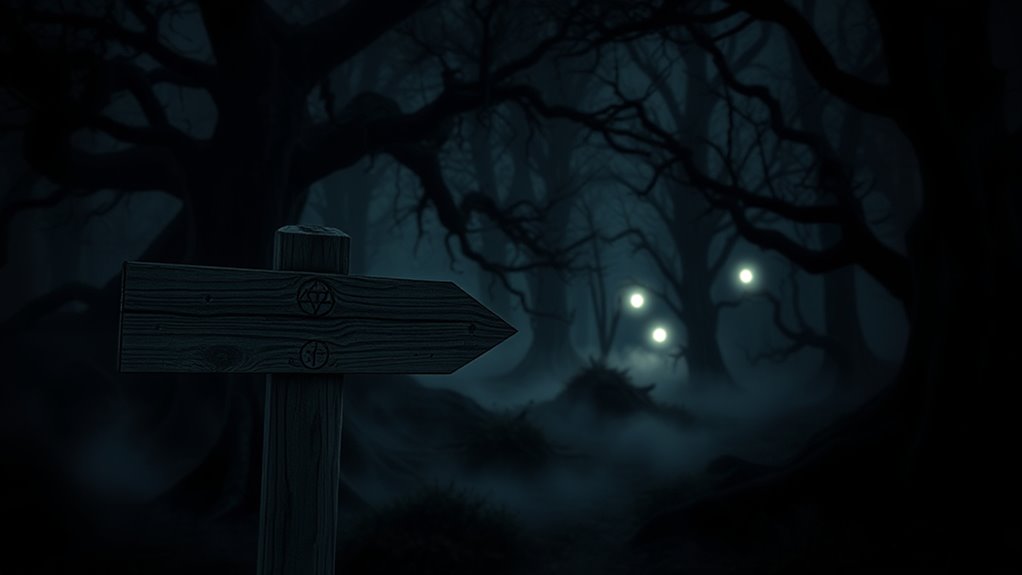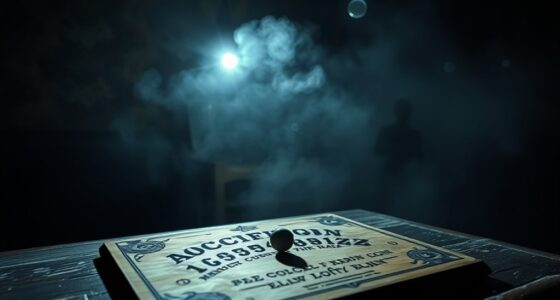As you listen to the clip, consider how cultural backgrounds shape your interpretation of the sound. It might be linked to historical reports of unexplained noises, like the “mystery booms” or “Seneca Guns.” Your emotional response could reflect personal experiences or collective beliefs. Remember, scientific insights reveal that many auditory phenomena may stem from illusions or environmental influences. Curious to uncover the deeper layers behind these enigmatic sounds? There’s more to explore about their fascinating history and technology.
Key Takeaways
- Analyze the sound’s characteristics, such as pitch and frequency, using audio spectrum analyzers to identify unusual patterns.
- Consider the possibility of environmental influences that may distort sound perception, leading to misinterpretations.
- Investigate historical context or cultural significance associated with the sound, as regional interpretations may vary.
- Use EVP recorders and other technology to capture and analyze any audio anomalies present in the clip.
- Evaluate emotional responses and context to understand how cultural backgrounds shape perceptions of the sound.
Unexplained Noises: A Historical Perspective
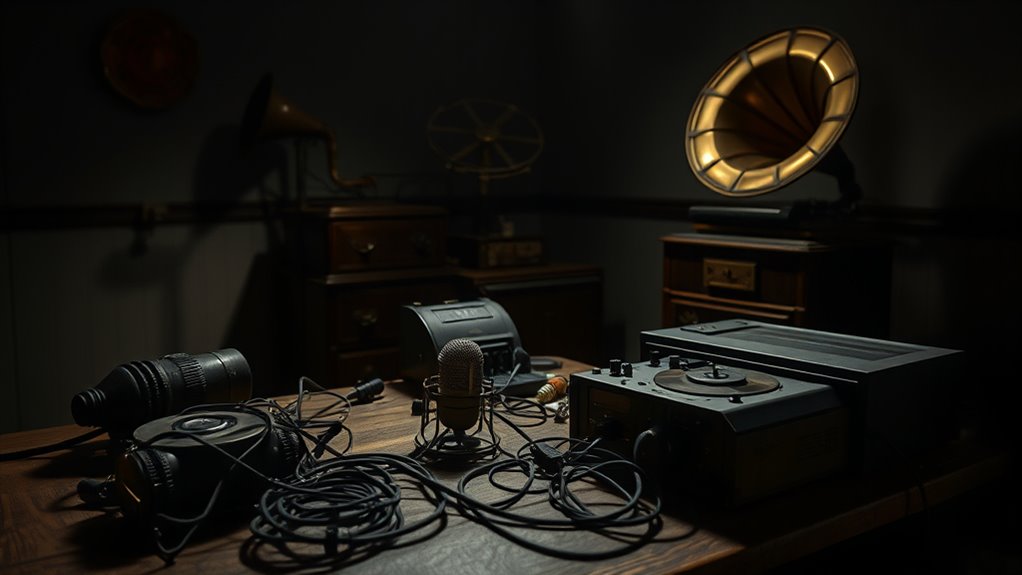
As you investigate the historical significance of unexplained noises, you’ll find that reports of phenomena like “mystery booms” have captured attention for decades, often leaving people puzzled about their origins.
Known as “Seneca Guns,” these sounds have been likened to thunder or gunfire and reported globally. Various regions have their own names for similar occurrences, such as “mistpouffers” in Belgium and “Barisal guns” in the Ganges Delta. Additionally, unusual infrasonic phenomena detected during high-altitude experiments have contributed to the discussions surrounding these mysterious sounds.
Literary figures like Washington Irving have referenced these sounds, adding to their mystique. The unpredictability and lack of explanation behind them continue to fascinate the public, fueling interest and speculation.
Despite scientific investigations, a unified explanation remains elusive, keeping the mystery alive in both academic and popular discussions.
The Role of Culture in Sound Interpretation

Cultural context shapes how you interpret sounds, influencing your perceptions and emotional responses. Your cultural background plays a significant role; some sounds might hold deep significance for you while being overlooked by others.
If you come from a collectivist culture, you may focus on sounds that reflect group dynamics, whereas individualist cultures might highlight personal experiences. Historical events can also color your interpretation, evoking specific memories or emotions tied to those sounds. The integration of cultural elements in music can further enrich your emotional response to various sounds.
In today’s globalized world, you might find diverse sound interpretations blending as cultures interact. The social context matters too—sounds in communal settings may feel different than when you’re alone.
Ultimately, your cultural influences create a unique soundscape in your mind.
Scientific Insights Into Paranormal Sounds
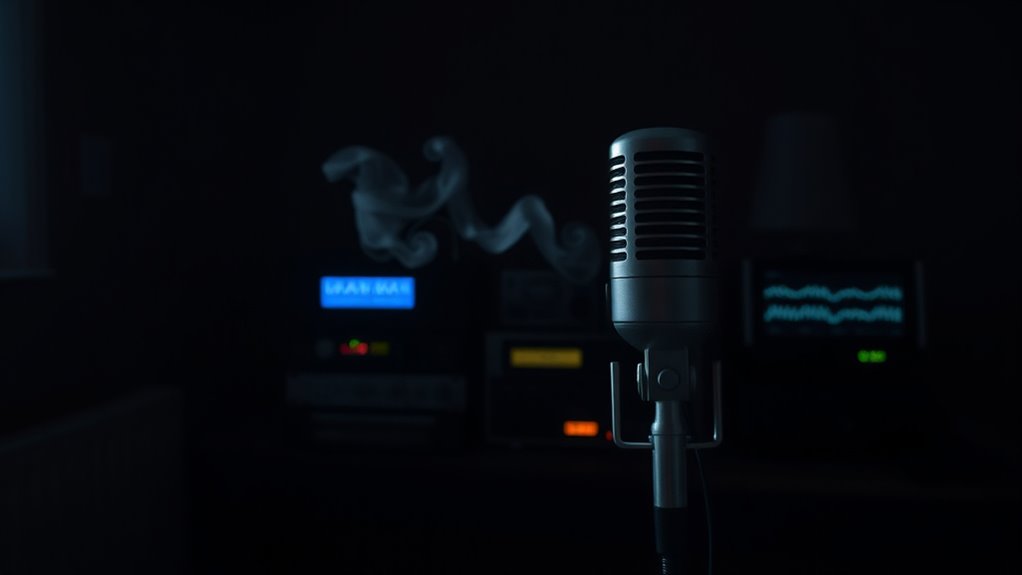
While many people attribute strange sounds to the paranormal, scientific insights offer a different perspective on these phenomena.
Auditory illusions, like echoes and reverberations, can easily mislead you into thinking you’re hearing ghostly voices. Electronic Voice Phenomena (EVP) often result from apophenia, where your brain seeks patterns in random noise. Additionally, sound waves reflecting off surfaces can create auditory illusions that mimic disembodied voices, further contributing to the eerie atmosphere.
Interference patterns can create silent zones, heightening the sense of the supernatural. Architectural designs, such as whisper galleries, manipulate sound, leading to mysterious auditory experiences. Additionally, natural phenomena and environmental influences can also distort sound perception. Ultimately, scientific scrutiny uncovers the psychological and acoustic factors behind these experiences, challenging the notion that they’re of paranormal origin.
Understanding these insights can reshape how you interpret strange sounds.
Capturing the Unseen: Technology and Equipment
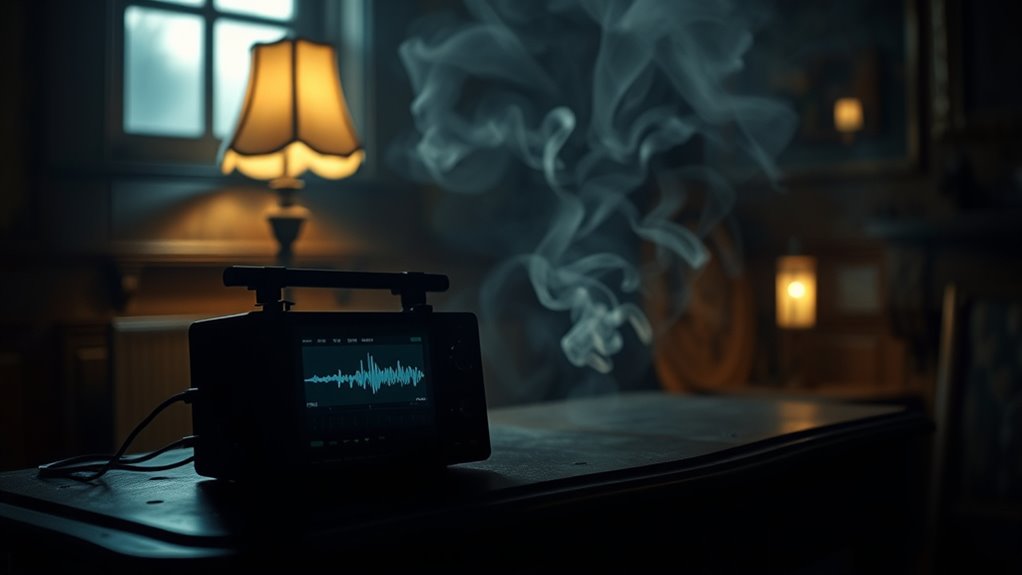
Scientific insights into paranormal sounds highlight the importance of using technology and equipment to investigate these phenomena. EVP recorders, for instance, capture audio anomalies that could indicate unexplained activity. Motion sensors alert you to movement, while audio spectrum analyzers identify frequencies beyond human hearing. Among these, the EVP Recorder is a popular choice for ghost hunters due to its affordability and effectiveness. Regular filter replacement ensures that your equipment operates efficiently, just as maintaining air purifiers is essential for optimal performance. Additionally, using low light office plants can help create a calming atmosphere that aids in focusing during investigations.
To visualize anomalies, infrared and thermal imaging tools are essential. Digital cameras serve as reliable evidence collectors. Additionally, EMF meters and K-II meters detect unusual energy fluctuations, critical for understanding paranormal occurrences. Strategic placement of these devices in active areas enhances your chances of capturing evidence.
The Influence of Media on Public Perception
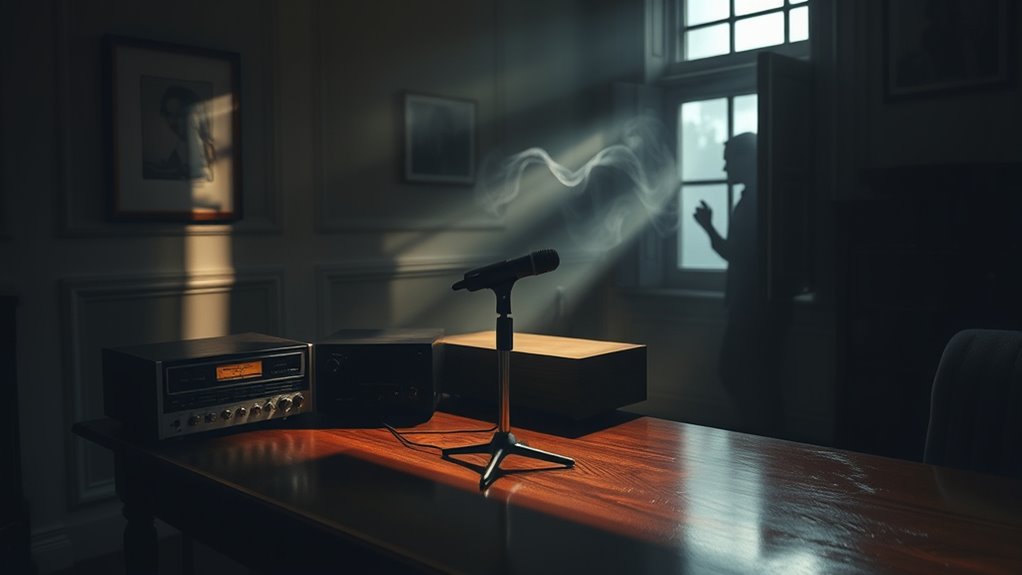
Media has a powerful role in shaping your perception of the paranormal, influencing how you interpret and understand these phenomena. From shows like “The X Files” to reality TV, the prevalence of paranormal content affects your beliefs.
As you consume this media, emotional engagement, such as fear or curiosity, enhances its impact. Research shows that over 40% of people believe in the paranormal, often influenced by the portrayal of investigators as scientific. Additionally, the strongest predictor of paranormal belief is regular viewing of paranormal-themed TV programs.
When media presents paranormal events as real, it boosts their credibility in your eyes. Regular exposure to these themes can strengthen your beliefs, especially when shared socially. The way media depicts the paranormal shapes not just your views, but also how society as a whole perceives these mysterious occurrences.
Frequently Asked Questions
How Can I Differentiate Between Paranormal and Natural Sounds?
To differentiate between paranormal and natural sounds, start by closely observing the environment.
Pay attention to factors like weather, building age, and any machines nearby that could produce noise.
Use sound recording devices to capture and analyze the frequencies.
If you can, conduct acoustic tests to pinpoint the source.
Finally, be mindful of your emotional state; fear and expectations can color your interpretations of ordinary sounds, so keep an open mind.
Are There Specific Locations Known for Mysterious Sounds?
Imagine standing on a foggy evening, hearing distant thunder, yet the sky’s clear. You’re not alone; places like Belgium, with its mysterious “mistpouffers,” and the Ganges Delta’s “Barisal guns” are known for such enigmatic sounds.
Italy’s “Brontidi” adds to the intrigue, while BC, Canada, reports eerie noises that spark curiosity.
Each location carries unique tales, blending natural phenomena and cultural lore, making them hotspots for the mysterious and unexplained.
What Should I Do if I Hear a Strange Sound?
If you hear a strange sound, first stay calm and analyze your environment.
Check for familiar sources like appliances or animals, and document the sound if possible.
Conduct some quick online research to see if others have reported similar noises.
If it feels threatening, keep your distance and inform those around you.
If the sound persists or seems suspicious, don’t hesitate to contact local authorities for assistance.
Can Animals Produce Sounds That Are Mistaken for Paranormal Phenomena?
Yes, animals can definitely produce sounds that might be mistaken for paranormal phenomena.
For instance, barn owls’ screeches can invoke fear, resembling a banshee’s wail. Tasmanian devils also create eerie barks and screams that unsettle people.
You might hear high-pitched whistles in narrow canyons, which can sound supernatural. These natural noises often trigger our biological fear responses, leading you to perceive them differently than their true origins.
How Do Personal Beliefs Affect Sound Interpretation?
Your personal beliefs shape how you interpret sounds in profound ways. When you hear something unfamiliar, your beliefs can heighten your curiosity or amplify your fear.
If you expect a sound to be eerie, you’re likely to feel unsettled. Conversely, if you believe it’s harmless, you might dismiss it.
Your past experiences, cultural background, and emotional state intertwine, guiding your understanding of sound, filtering out what you think you hear through the lens of your convictions.
Conclusion
As you investigate the mysteries of unexplained sounds, remember: isn’t it intriguing how a simple noise can spark the imagination and evoke fear? Your perspective shapes what you hear, turning the ordinary into the extraordinary. With advancements in technology and a deeper understanding of cultural contexts, you’re equipped to explore these enigmatic sounds like never before. So, what will you discover next? The world of the paranormal is waiting for your curious ears to listen closely.
